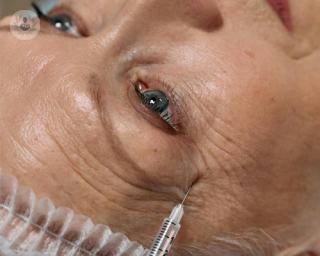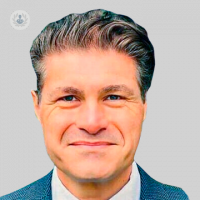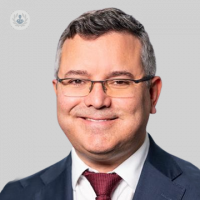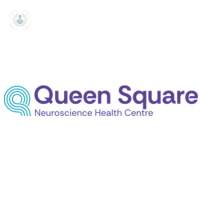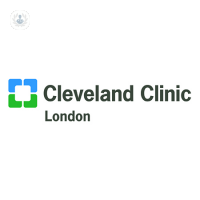Hemifacial spasm
Mr Jonathan Hyam - Neurosurgery
Created on: 05-01-2024
Updated on: 05-10-2024
Edited by: Conor Dunworth
What is hemifacial spasm?
Hemifacial spasm is a neurological disorder characterised by involuntary muscle contractions on one side of the face. These spasms typically begin around the eye and then gradually progress to involve other facial muscles, causing twitching or jerking movements. The condition can be distressing and affect one's quality of life, but it is not life-threatening.

What causes hemifacial spasm?
The primary cause of hemifacial spasm is believed to be compression or irritation of the facial nerve, known as the seventh cranial nerve. This nerve controls the muscles of facial expression, and when it is compressed or irritated, it can send faulty signals to the facial muscles, resulting in spasms.
One common cause of this compression is the pressure exerted on the facial nerve by a blood vessel, typically an artery, as it exits the brainstem and enters the facial region. Over time, this compression can lead to the development of hemifacial spasm.
Other potential causes include facial nerve injury, tumours pressing on the nerve, or sometimes, it can occur without a clear cause. This is known as idiopathic hemifacial spasm.
What are the treatments for hemifacial spasm?
Treatment for hemifacial spasm aims to alleviate symptoms and improve quality of life. The most common treatment options include:
- Medications: Certain medications, such as muscle relaxants or botulinum toxin (Botox) injections, can help reduce muscle contractions and alleviate symptoms. Botulinum toxin injections are particularly effective and are often the first-line treatment for hemifacial spasm. These injections work by temporarily paralysing the muscles responsible for the spasms.
- Surgery: In cases where medications and other conservative treatments are ineffective, surgery may be recommended. One surgical option is microvascular decompression, where the offending blood vessel compressing the facial nerve is repositioned or padded to relieve pressure. Another surgical technique involves selectively cutting the nerves responsible for the spasms, known as facial nerve decompression or rhizotomy.
- Physical therapy: Physical therapy techniques, such as facial exercises and massage, may help reduce muscle tension and improve facial muscle control. However, the effectiveness of physical therapy alone in treating hemifacial spasm is limited compared to other treatment modalities.
Is hemifacial spasm painful?
While the spasms themselves are not usually painful, they can cause discomfort and embarrassment due to their involuntary nature and their impact on facial appearance.
Is hemifacial spasm a progressive condition?
Hemifacial spasm typically worsens over time, with the frequency and severity of spasms increasing gradually. However, with appropriate treatment, symptoms can be managed effectively, and the progression of the condition can be slowed or halted.
Can hemifacial spasm be cured?
While there is no cure for hemifacial spasm, treatments such as medications, botulinum toxin injections, or surgery can effectively manage symptoms and improve quality of life for individuals affected by the condition.
Are there any complications associated with hemifacial spasm?
In some cases, hemifacial spasm can lead to social and psychological difficulties due to its impact on facial appearance and function. Additionally, prolonged muscle contractions can cause muscle fatigue and discomfort. However, with appropriate treatment, these complications can often be minimised or avoided.

